Featured image: Creative Commons License by Lindsey Turner
The musical mind behind the record-shatteringly popular “Seven Nation Army”, Jack White is responsible for a long list of chart-topping bops and earworm tracks. In part, that’s thanks to his distinctive blues sound and sonic identity, a character he’s nurtured and developed through a wide selection of equipment and rigs.
In this article, we take a look at the highlights of these extensive setups, so you can get the ultimate lowdown on Jack White’s guitars and gear. Discover the cool axes, pedals, and vintage amps he’s used to craft his spiky octaval tones and warm breakup drawls – including that iconic red offset which powered his early White Stripes records!
In a hurry?
Here’s a quick list of the main gear White’s used throughout his career:
| Gear Type | Item |
|---|---|
| Electric guitar | Valco Airline Res-O-Glass "JB Hutto" |
| Kay Archtop Semi-Acoustic | |
| 1970s Crestwood Astral II | |
| Gretsch Electromatic Triple Jet | |
| Fender Telecaster Custom | |
| Gretsch Anniversary Jr “The Green Machine” | |
| Gretsch Jupiter Thunderbird | |
| Fender Three-Wheel-Motion Low-Rider Telecaster (Blue) | |
| Acoustic guitar | Gretsch Rancher Falcon RITA HAYWORTH |
| Gibson L-1 Archtop - Robert Johnson 1911 Model | |
| Amplifier | 1960s Sears Silvertone 1485 "Six Ten" |
| 1960s Fender Twin Reverb | |
| Effects pedal | DigiTech Whammy Pitch Shifter |
| Electro Harmonix Big Muff Pi |
Jack White’s electric guitars
Valco Airline Res-O-Glass “JB Hutto”
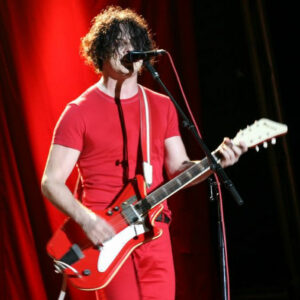
Creative Commons License by Michael Morel
Iconic. Incredibly red and so utterly defining of the White Stripes era, the Airline Res-O-Glass “JB Hutto” was White’s go-to electric for the early to mid-2000s. A cheap vintage electric, it provided the tones for much of his early work despite being a relatively obscure model.
It was a low-cost catalogue product that mimicked the designs of popular guitars like Fender’s Jazzmaster but featured none of the high-end components.
That’s because they were intended for beginners or players on a budget, and so their fibreglass (Res-O-Glass for marketing purposes) construction had price efficiency in mind rather than tone or performance.
The build was essentially pieces of Res-O-Glass pressed together over a maple neck, forming a hollow body with a wooden centre block. Mounted on the block were the single coil (not humbucker!) pickups that gave the eccentric instrument its unique voice.
Ironically, it’s this cost-cutting approach that’s given the odd cutaway its cult status, helped along by White bringing it back into the spotlight.
Although the Airline featured in the video for “Seven Nation Army”, it was actually White’s semi-acoustic that provided the sounds. For most other electric tracks on the album Elephant, the old Valco riff machine can be heard.
Kay Archtop Semi-Acoustic
Another instrument from the catalogue era, the Kay Archtop is/was “a lot of guitar at a very little price!” (according to its original catalogue listing). As Jack White’s first six-string, the Kay Archtop probably bears the most significance for him as a player and kickstarted his love for blues slide styles.
That’s most evident in “Seven Nation Army”, where the venerable Archtop provided all the sounds. From the DigiTech-deepened drop bass line to the crescendo slide solo towards the end, it’s this old-but-gold semi-acoustic that you can hear throughout, despite what the video might make you believe.
Like his distinctive Valco Airline, the Kay Archtop was sold in catalogues and department stores, aimed at budget-minded players. It was a “crackproof” maple hollow body with elegant F-holes, electric-focused magnetic pickups, and an auditorium-sized body.
The original sunburst finish has since vanished on White’s model, taped over with brown Kraft paper. A move which was either an aesthetic or feedback-fighting choice – we can only guess, however, as the man himself won’t tell!
1970s Crestwood Astral II
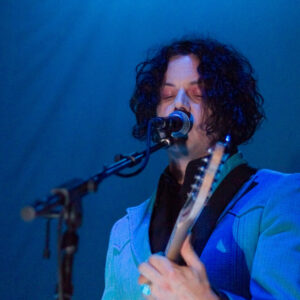
Creative Commons License by William Haun
Another White Stripes Hall of Fame resident, the Crestwood Astral II was one of White’s main workhorses before he took up the Airline.
You can hear this funky Japanese hollow body on tracks like “I Fought Piranhas” and “Let’s Build A Home” from their first two albums.
Its semi-acoustic design is reminiscent of mainstays like the Gibson 335 and the Gretsch Electromatics, with elegant curved edges and a double cutaway build.
Its trem tailpiece adds vibrato excitement, not that you can hear White use it much on the early stuff. The Astral’s maple body gave it a bright twang and plenty of resonance to carry notes.
Speaking of notes, two single coil pickups provided a surfer-esque voice that lit up California in the ’60s, a chimey tone that White brought out in their self-titled 1999 debut album. A true garage rock classic!
Gretsch Electromatic Triple Jet
A journey to the present, and we reach a guitar that White continues to use. The Gretsch Electromatic Triple Jet is actually pretty different from most of his guitars, with its solid mahogany construction and dual humbuckers providing an almost Les Paul-like sound.
But there are similarities too, like the Licenced Bigsby B50 Vibrato tailpiece, the master tone and volume controls mounted on a curvy pickguard, and an overall elegance that’s particularly pronounced in its sunburst finish. White has been using this as his main guitar for live shows since 2006 and used it to record much of Icky Thump.
Gretsch Anniversary Jr “The Green Machine”
It’s time to get weird. That’s what we’d like to imagine White instructed his famous Luthier Randy Parsons when requesting a follow-up to his “Triple Jet” Gretsch used with The Raconteurs. White wanted a guitar that was as unique as he is, and so he chose an eclectic group of appointments to help channel his bluesy spirit.
Chief amongst those was a Green Bullet microphone installed in the lower body and mounted with a vacuum pull cord. This produces gnarly distorted vocals at arm’s reach, while a light-based theremin on the bridge allows White to create ethereal sci-fi waves with a flick of his wrist. Some more ergonomic features include an extra MXR micro amp pickup, a wooden armrest, and a mechanical foam dampening pad.
Oh – on top of all that – this was a single-cut model hewn into a double-cut! So proud of this magnificent “Green Machine” was White that he featured it in the seminal It Might Get Loud documentary in 2008 (seen below).
Gretsch Jupiter Thunderbird
Not many rig rundowns can claim to involve Martini-obsessed fictional super-spy James Bond, but this one can. Albeit loosely. This mighty Gretsch Thunderbird was used by White on the recording for 2008’s “Another Way To Die” for the JB movie Quantum Of Solace.
In that track and its accompanying music video, you can see the Jupiter Thunderbird on full display, in addition to White’s signature fuzzy tone. Inspired by Bo Diddley and his use of the JT, White even wanted to perform the song live with an entire band outfitted with Thunderbirds!
Alas, Quantum of Solace generated a quantum amount of interest, and so this live performance never came to fruition.
Fender Three-Wheel-Motion Low-Rider Telecaster (Blue)
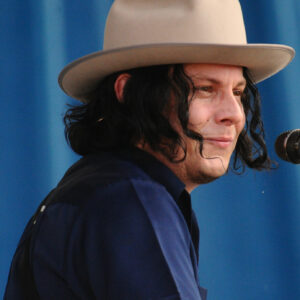
Creative Commons License by WFUV Public Radio
We’ve referred to White’s bluesy character a few times already, but in 2022 he took that appellation quite literally and rocked Glastonbury with a shock-blue hairdo and guitars with a similar electric colour scheme.
One such guitar was his custom Tele which brought quintessential Fender vibes mixed with a few extra Jack White mods. Those included a quirky set of pickups to generate all kinds of sounds, a unique Bigsby-style tremolo, a Gretsch armrest, and a kill switch to cut up his notes with a stuttery and spluttery effect.
The pickups are the real centrepiece, armed with a Thinline Tele Wide Range humbucker at the neck (which belonged to one of White’s brothers!), a P90 style middle pup, and a Filter’Tron bridge for White’s favourite Gretsch purrs.
Fender Telecaster Custom
Another guitar that has graced White’s setup is the Fender Telecaster Custom. This versatile and beloved model features a solid body with an ash finish, but what makes it unique is its combination of two single coil pickups in the neck position and one humbucker in the bridge.
White used this guitar on several tracks from Get Behind Me Satan, including “Blue Orchid” and “My Doorbell”. Its bright, twangy tone is perfect for rock songs with a touch of country influence, making it a favourite among many musicians.
Jack White’s acoustic guitars
Gretsch Rancher Falcon RITA HAYWORTH
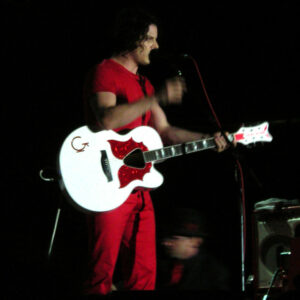
Creative Commons License by Bene Riobó
“Visually striking” doesn’t quite do Jack White’s Rancher Falcon justice.
It’s dressed in bold white and red livery and sports a few unique design choices. Things like a triangle-shaped soundhole, cool Gretsch headstock, and gorgeous symmetrical pickguard set it apart from your usual acoustic and really make it stick in the memory.
Clearly, it had the same effect on White! He used it for the entire Icky Thump tour and favoured Gretsch Ranchers for their meaty bass response when playing live.
Most notable of all its quirky features though is the large Rita Hayworth portrait on the back of the guitar. The famous actress was something of an obsession for White, who made the Hollywood Icon the subject of his songs “White Moon” and “Take, Take, Take”.
Gibson L-1 Archtop – Robert Johnson 1911 Model
This 1911 beauty was still being put to work by Jack White 100 years after its creation. Believed to be 100% original parts without any mods or tweaks, this is about as vintage as guitars get.
Heavily associated with famous bluesman Robert Johnson, it’s easy to see why this distinctive and diminutive guitar would hold such appeal for White.
As for appearances, you can see him play it in the It Might Get Loud film and several live shows.
Jack White’s amps
1960s Sears Silvertone 1485 “Six Ten”
This classic stack has similar origins to White’s two favourite White Stripes guitars. As its name suggests, it was sold in the Sears catalogue in the ’60s and featured a 120-watt tube head with a six 10″ speaker cabinet (hence “Six Ten”).
You can hear the raspy and vintage tones of the Silvertone throughout the first three White Stripes albums, but without any of the built-in reverb that the Silvertone could provide. Today these classic amps are rare and can command hefty prices for mint condition items, but if you’re prepared to fix up an old Silvertone you can get the same gnarly shrieks and characterful fuzz that White loves so much!
1960s Fender Twin Reverb
Not much to say about a classic Fender Twin Reverb other than it’s become Jack White’s go-to amp in more recent days. For the White Stripes times, he’d blend the Fender’s reverb with his Silvertone to get a more complete sound character. Unsurprisingly, he preferred Fender’s warm and luscious spring reverb over the Silvertone’s, which he described as being “horrible”.
The debate between digital and analogue FX rages on, but a purist like White will always appreciate the versatility and depth of Fender’s amp reverb, which can range from adding a little bit of spice to notes to imbuing a resounding cathedral-style echo.
Check out this 2005 Glastonbury set to see his Fender and Silvertone backline in action!
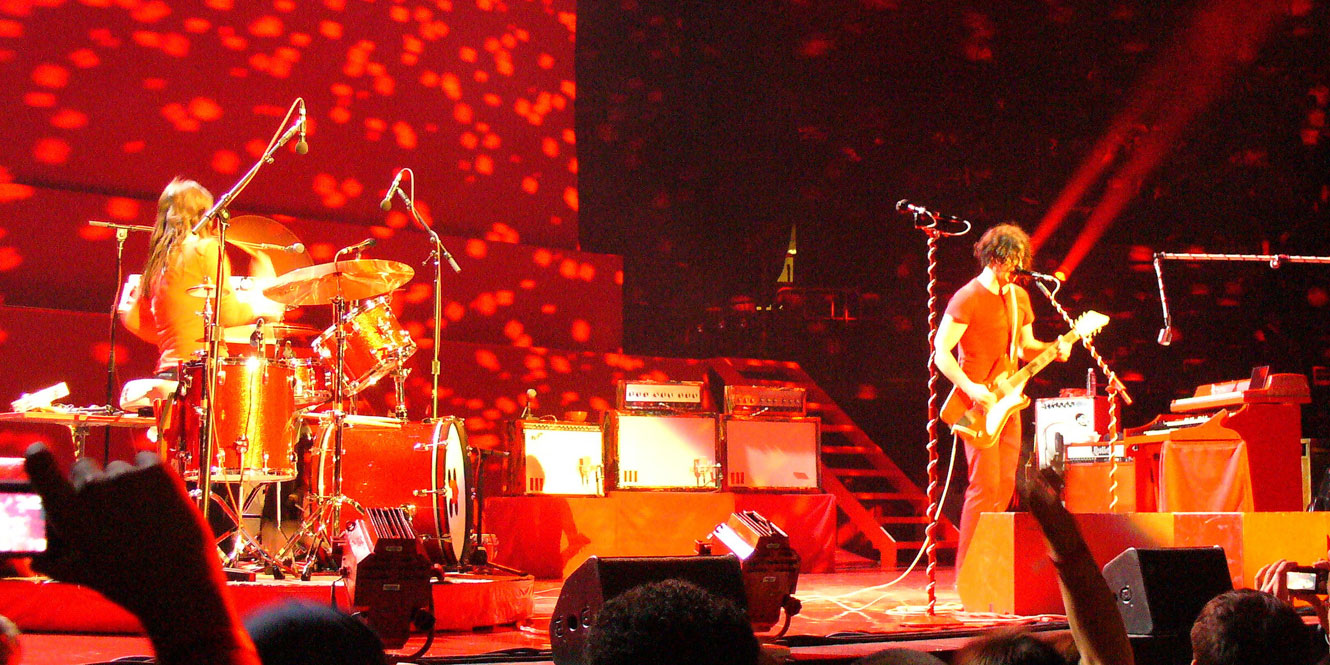
Creative Commons License by Wally Gobetz
Jack White’s pedals
DigiTech Whammy Pitch Shifter
The DigiTech Whammy Pitch Shifter is what we have to thank for Seven Nation Army’s captivating bassline. White used it in the octave-down setting with his Kay Harmony semi-acoustic to create that spongy and rumbly timbre.
Outside of that colossal hit, he used both the whammy pedal and pitch-shifting feature to let his solos ring out at a higher pitch. In addition, he loved to create interesting textures that would stand out from backing music, either in low or high octaves. Combined with his signature fuzz tones, the DigiTech pedal contributed a lot to his sound profile.
Electro Harmonix Big Muff Pi
A pedal all-time great, the Big Muff is a stalwart feature on many pedalboards. Its creamy and hairy fuzz tones have given energy to so many recognisable tracks and artists that it’s no surprise White found a home for one on his board.
With just this one pedal you’re most of the way to getting White’s tone on many of his tracks (“Icky Thump”, “Seven Nation Army” solo, “Girl, You Have No Faith In Medicine”). You might need to add in an MXR micro amp and an EHX octave pedal to complete the set.
Strings, picks, and technique
Strings and picks
As for the fine details, there’s not too much to say. White seemingly has no preference for strings and likes to let his guitar tech slap on whatever set is at hand.
As for picks, White’s most often seen fingerpicking – but when he opts for a plectrum it’s usually a thick gauge (1.38mm) to allow for a strong attack.
White’s playing techniques
White’s technique is delightfully varied throughout his career. As a self-taught musician, he found he had a non-standard way of fingering some barre chords and other techniques – and a trait he was delighted to find that he shared with Pete Townshend.
Much of his White Stripes work featured fast punky power chords augmented with catchy riffs and shrieking solos. In this recent performance, you can see White improvising a pentatonic solo for “Dead Leaves On The Dirty Ground”, which transitions from high-end hard picking to softer lower-fret fingerpicking.
Another essential component of his solos is his DigiTech Whammy pedal which he’d use to throw notes up pitch and create a vibrant tone that stands sharply apart from the main track. Lately, he’ll use a B-bender contraption on his custom Tele to bend the B string with his wrist, mimicking a lap steel guitar.
And perhaps most important of all is the slide playing. Achieved with a simple glass tube on his pinky finger, slide guitar is rooted in American blues and translates naturally to White’s lead playing. “Seven Nation Army”, “I Want To Be The Boy To Warm Your Mother’s Heart”, and “Let’s Build a Home” are just a few songs that feature it.
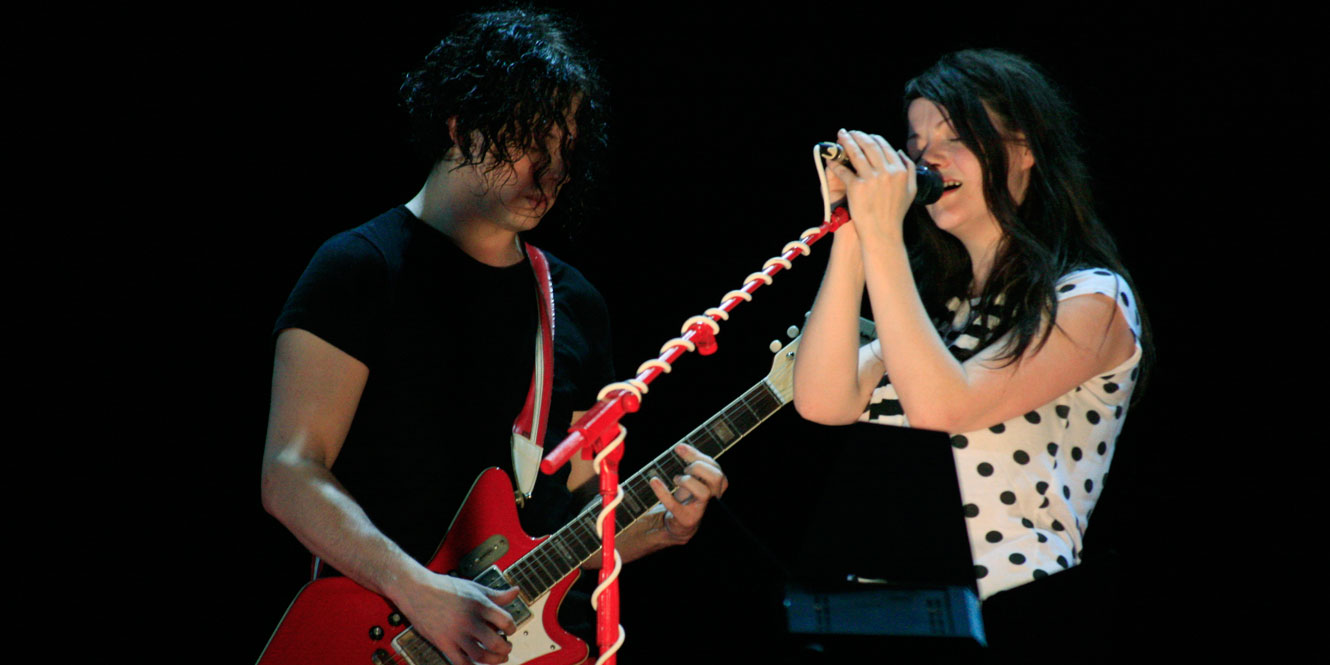
Creative Commons License by Fabio Venni
FAQs
What guitars does Jack White use?
Jack White’s eclectic guitar collection includes a Fender Telecaster Custom, Gibson L-1, Gretsch Electromatic Triple Jet, Gretsch Jupiter Thunderbird, and a customised Fender Telecaster.
What was Jack White’s first guitar?
Jack White’s first guitar was a Montgomery Ward Airline 2P DLX, famous for its distinctive red and white fibreglass body, which became iconic in his performances.
What guitar does Jack White play on Icky Thump?
Jack White played a 1957 Gretsch White Penguin electric guitar on his acclaimed album Icky Thump, showcasing its rich, versatile sound. You can see him play it in the music video for the song “Icky Thump”.
Final thoughts
From his early White Stripes days to his recent blue-themed solo career, Jack White’s guitars comprise an eclectic bunch of axes that helped foster his garage rock mantra and classic American rhythms.
The idea that White’s all about old analogue stuff is disproven by his love of the DigiTech Whammy and EHX octave pedal, while his refined tastes can be seen in the many Gretsch instruments he’s had customised over the years.
If you’re interested in any other artist’s setups, why not take a look at our Jimmy Page or James Hetfield gear run-downs?

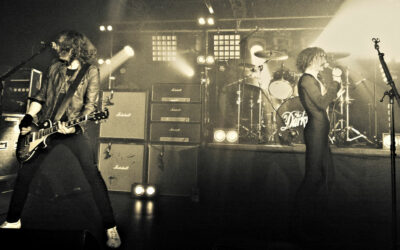
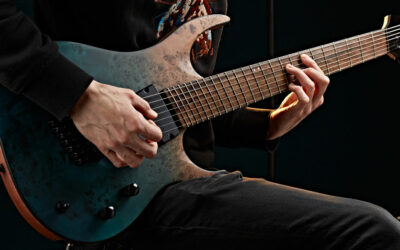
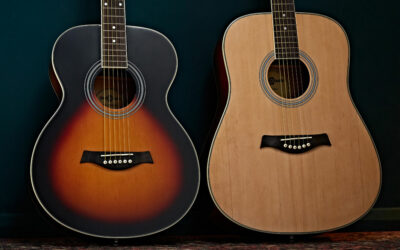

0 Comments